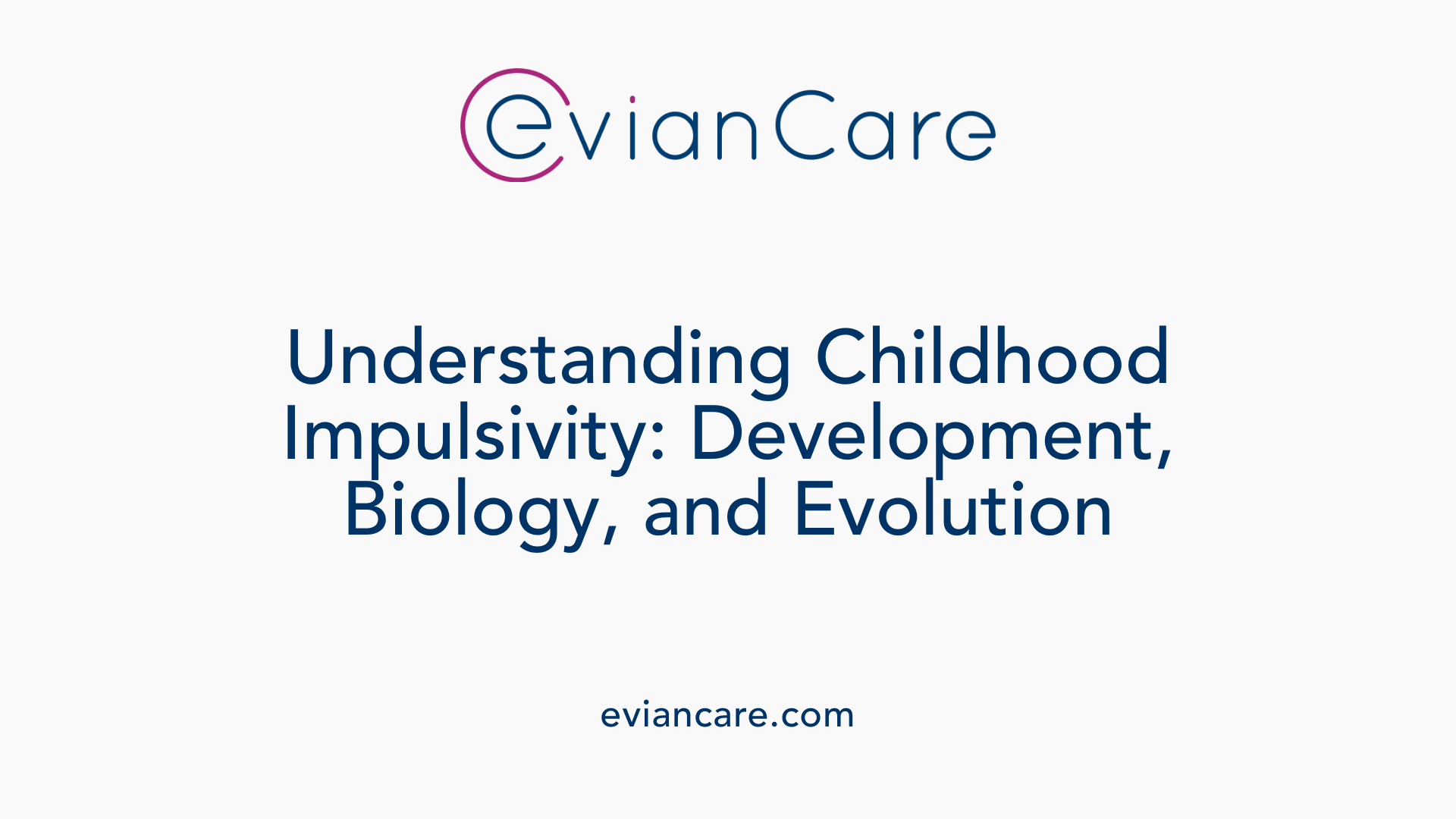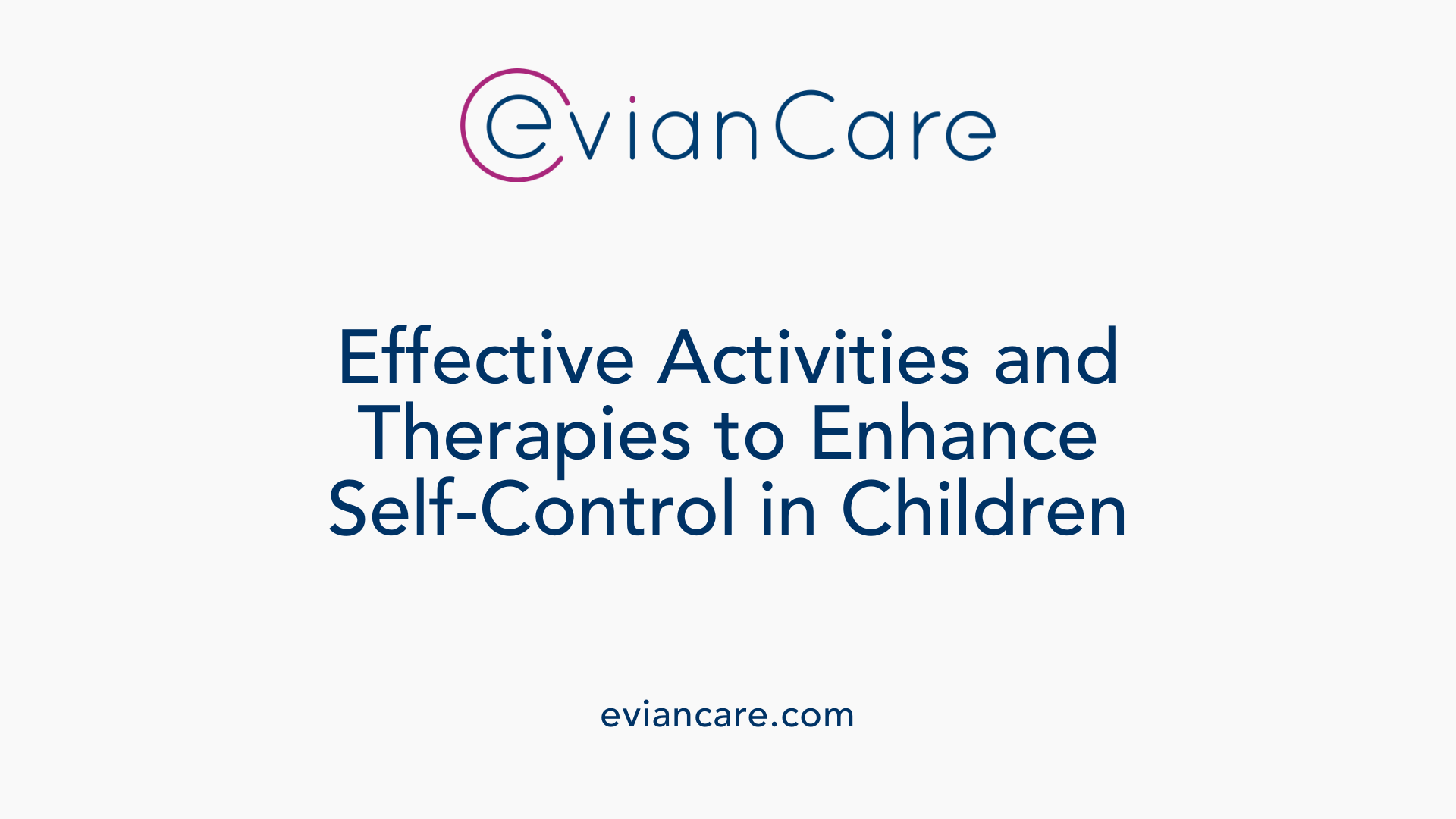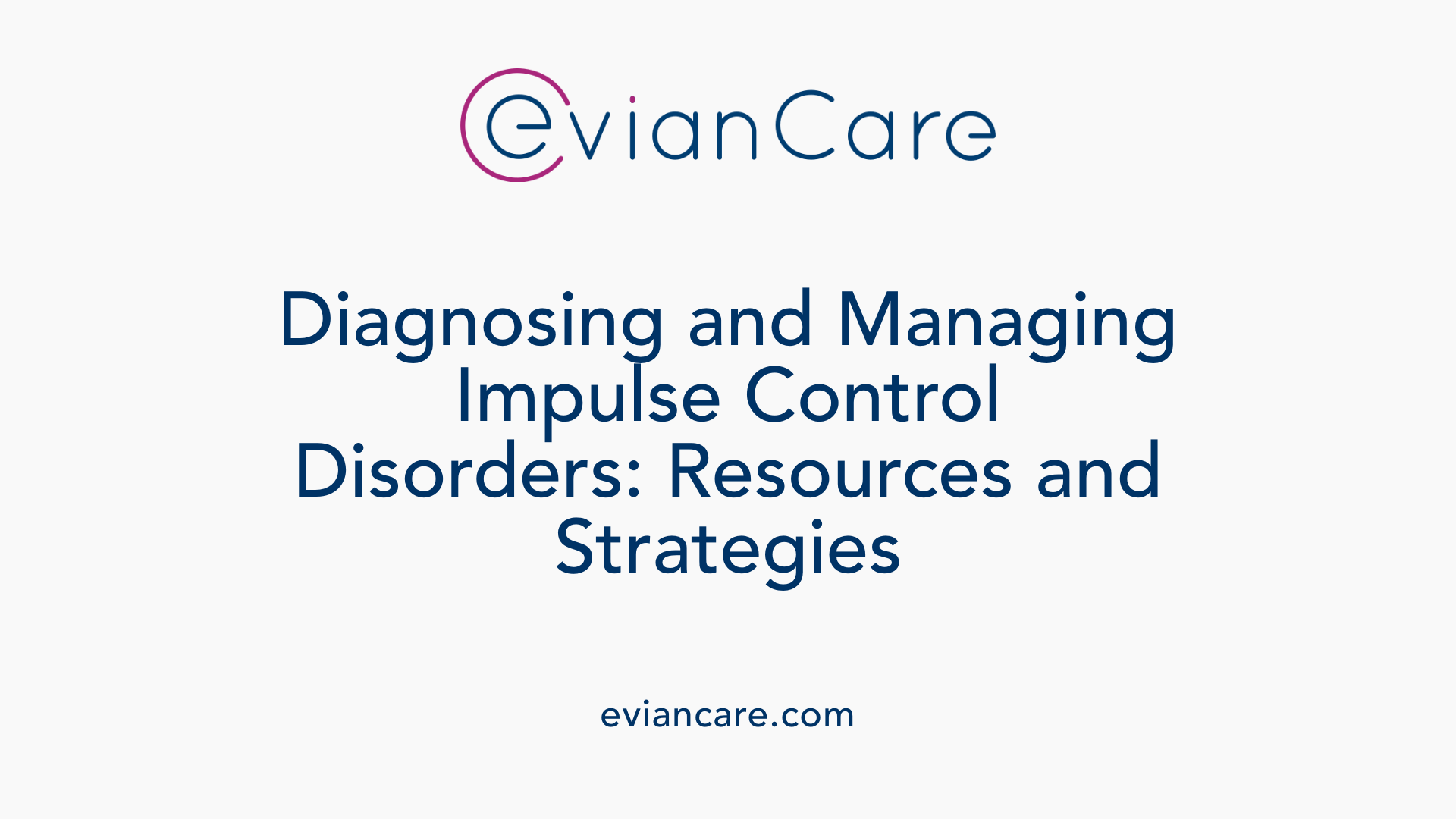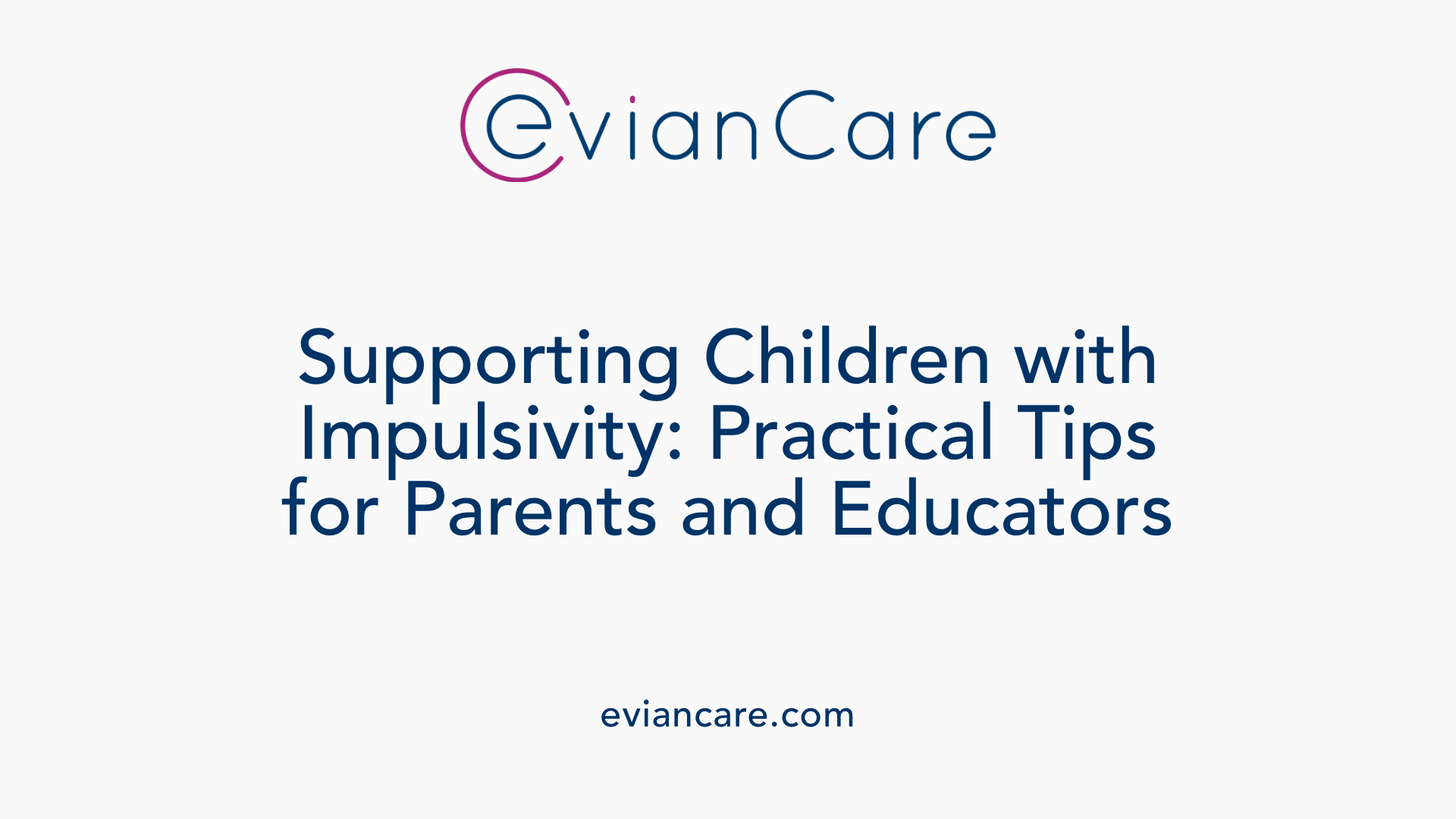
Understanding Impulse Control Challenges in Children
Impulse control issues are common in childhood and can significantly impact social, academic, and emotional development. Recognizing and effectively managing these behaviors is critical for fostering healthier growth and better functioning across different settings.
The Foundations of Impulsivity in Childhood

Developmental aspects of impulse control
Impulsivity is a natural part of childhood development. Typically, children begin to develop self-control skills around 3.5 to 4 years old, although signs can appear as early as 18 months. During this period, children learn to manage their immediate reactions and impulses through experiences and guidance from adults. Activities that promote self-regulation include games like 'freeze and focus,' where children practice stopping movement in response to cues, and mindfulness exercises that foster awareness of bodily sensations and emotions.
Biological and genetic factors influencing impulsivity
Impulsivity has a biological basis rooted in brain development, particularly involving the prefrontal cortex—the region responsible for judgment, planning, and impulse regulation. As explained by counselor Edward F. Hudspeth, an underdeveloped prefrontal cortex in young children contributes to their impulsive behaviors. Genetics also play a significant role, with some children inheriting tendencies toward impulsivity, which can be influenced by environmental factors such as stress or trauma.
Peak age for impulsiveness and its evolution
Impulsivity tends to peak during childhood, with behaviors manifesting as acting without thinking, interrupting, or sharing difficulties. As children grow, these behaviors often evolve. In adolescence and adulthood, impulsivity may become more complex, sometimes leading to disruptive or harmful actions. While impulsiveness naturally declines with age as brain development progresses, for some individuals, it persists as part of broader impulse control disorders, requiring targeted interventions.
For those seeking resources or guides on behavioral interventions, reputable healthcare providers and organizations specializing in child behavioral issues offer valuable educational materials. Parents and caregivers can support children with impulsivity by creating structured routines, establishing clear rules, providing immediate positive or corrective feedback, and modeling self-control. Consistency in these strategies fosters emotional regulation and helps children develop essential self-management skills.
| Aspect | Details | Additional Notes |
|---|---|---|
| Age Development | From 18 months to 4 years, self-control skills develop gradually | Critical period for intervention |
| Biological Factors | Prefrontal cortex development, genetic predisposition | Brain maturity influences impulsivity |
| Evolution of Behaviors | Peak in childhood, decline in adolescence, potential persistence in adulthood | Intervention can mitigate long-term effects |
Understanding how impulsivity develops helps caregivers and professionals create supportive environments that foster better self-control in children.
Behavioral Techniques and Intervention Tools

Are there specific activities or techniques to improve impulse control in children or teenagers?
Yes, there are numerous activities and techniques proven to help children and teenagers develop better impulse control. Structured routines and reward systems, like the marble jar, encourage patience and goal-setting. Fun, game-based activities such as Simon Says and freeze dance teach children to pause and think before acting, making self-regulation engaging and interactive.
Role-playing real-life situations allows youngsters to practice self-control in social contexts, helping them understand appropriate responses. Incorporating sensory activities like playing with sensory objects or engaging in calming exercises can also aid in emotional regulation.
Teachers and parents can reinforce these skills by establishing clear goals, using visual reminders, modeling calm behavior, and encouraging good habits such as maintaining a healthy sleep schedule and managing stress. When combined with guidance from professionals, these methods can significantly improve impulse control and overall executive functioning.
What role does emotion regulation play in managing impulsivity, and how can therapy facilitate this?
Emotion regulation plays a vital role in controlling impulsive behaviors because many such behaviors are driven by emotional reactions like frustration, anger, or excitement. Therapeutic approaches focus on helping children recognize and understand their feelings, which is essential for managing impulses.
Techniques like emotion recognition exercises teach children to identify and name their emotions, creating awareness of emotional triggers. Therapy methods such as somatic experiencing involve body awareness practices that help calming the nervous system, which reduces impulsiveness triggered by heightened emotional states.
Body-based sensory engagement and mindfulness practices improve distress tolerance, enabling children to sit with difficult emotions without reacting impulsively. These strategies foster emotional self-awareness and promote healthier behavior responses, ultimately helping children develop better self-regulation skills.
Behavior Therapy Techniques for Managing Impulsivity
What are effective behavioral therapy techniques for managing impulse control issues in children?
Managing impulsivity in children often involves a range of behavioral therapies that target emotional regulation, self-control, and social skills. One widely used approach is cognitive-behavioral therapy (CBT). CBT enables children to identify what triggers impulsive actions, develop strategies to cope with urges, and change problematic behaviors. For example, children learn to recognize thoughts that lead to impulsive reactions and practice replacing them with calmer, planned responses.
Play-based interventions such as the Dina Dinosaur Treatment Program exemplify how therapy can incorporate fun and engaging activities to teach emotional awareness, empathy, and anger management. These programs use role-play, storytelling, and model behaviors to help children understand their emotions and learn appropriate ways to express themselves.
Family involvement is also vital. Techniques such as behavior reinforcement, consistent routines, and behavior contracts help create a supportive environment that encourages positive behavior. Family therapies like Multisystemic Therapy (MST) involve parents and caregivers, providing them with skills to reinforce strategies at home and reduce environmental triggers for impulsive behavior.
Overall, combining these behavioral techniques—therapy, play, and family involvement—helps children gain better control over impulses and build healthier social interactions.
Diagnosis and Treatment of Impulse Control Disorders in Children

How is impulse control disorder diagnosed and addressed in children?
Diagnosing impulse control disorder (ICD) in children involves a thorough assessment process that includes behavioral observations, clinical evaluations, and detailed input from parents, teachers, and healthcare professionals. Clinicians look for symptoms such as frequent temper tantrums, impulsive actions, irritability, anger outbursts, and difficulty controlling urges. These behaviors are often documented over time and in different settings to understand their persistence and impact.
A comprehensive evaluation also examines family history and possible contributing factors like Attention Deficit Hyperactivity Disorder (ADHD), exposure to trauma or violence, and environmental influences. Identifying co-occurring conditions, such as depression or anxiety, is crucial, as they can influence treatment strategies.
Addressing ICD in children generally includes behavioral therapies. Cognitive Behavioral Therapy (CBT) is widely used to help children recognize thought patterns that lead to impulsive actions and develop healthier coping strategies. Parent Management Training (PMT) teaches parents how to reinforce positive behaviors, establish consistent routines, and set effective limits.
In some cases, medications may be prescribed, especially if there are comorbid conditions like anxiety or mood disorders. Although no medications are FDA-approved specifically for ICD in children, healthcare providers may consider antidepressants, mood stabilizers, or stimulants appropriate to the individual case.
A vital part of treatment involves creating a structured and predictable environment. Establishing clear rules, using reward systems, and teaching emotional vocabulary help children develop impulse control. Strategies such as routine schedules, calm discipline, and supervision at home and school, support children in practicing self-regulation and reducing problematic behaviors.
What resources are available for managing impulse control issues?
Parents and caregivers seeking assistance with impulse control issues can access numerous resources, including educational materials, support groups, and professional services. Healthcare providers specializing in child psychology or psychiatry can develop personalized treatment plans. Reputable online organizations and health websites provide guides on behavioral strategies, parenting techniques, and intervention programs.
Local clinics, schools, and community health centers often offer behavioral intervention programs, social skills training, and family therapy sessions. Books and online courses also serve as useful tools for understanding and managing impulse control disorders in children. Partnering with teachers and school counselors ensures consistency between home and school environments, which is vital for effective management.
Overall, proactive and comprehensive management combining therapeutic intervention, parental support, and community resources can significantly improve impulse regulation in children and foster healthier development.
Reducing Impulsivity with Parental and Educational Strategies

What strategies can parents and caregivers use to support children with impulse control difficulties?
Parents and caregivers play a crucial role in helping children develop better impulse control. Establishing clear and consistent household rules provides children with a sense of structure and predictability. These rules should be simple, age-appropriate, and reinforced regularly.
Providing immediate and positive reinforcement when children exhibit self-control encourages repeat behaviors. Reward systems such as token economies or sticker charts can motivate children to practice patience and restraint. Creating structured routines helps children understand expectations and reduces impulsive reactions caused by uncertainty or chaos.
Consistent consequences for impulsive actions, like losing a privilege or extra chores, teach children about the direct link between behavior and outcomes. A supportive environment that includes patience, understanding, and ongoing encouragement fosters the development of self-regulation skills.
What are effective behavioral techniques parents and teachers can implement at home and school?
At home and in the classroom, predictable routines and specific rules help children manage impulsivity. Building a daily schedule that includes designated times for activities, breaks, and quiet time provides stability and minimizes impulsive disruptions.
Reward systems, such as point charts or small prizes, reinforce positive behavior. Immediate positive reinforcement, like praise or a high-five, can be very effective in encouraging children to practice self-control.
Clear, consistent consequences for impulsive behavior are essential. For example, if a child interrupts, a gentle reminder to wait or a brief timeout can help them learn appropriate responses.
Another effective approach involves collaboration among parents, teachers, and counselors. By working together, they can ensure consistency across settings, which strengthens a child's understanding and internalization of behavioral expectations.
Engaging children in social skills training, emotion regulation exercises, and impulse control games—such as 'Simon Says' with mindful instructions—also enhances their ability to pause and think before acting. Ultimately, a combined effort that emphasizes patience, structure, and positive reinforcement paves the way for meaningful progress in managing impulsivity.
The Long-Term Outlook and Effectiveness of Behavioral Therapy
What is the prognosis for children with impulse control disorders?
Children diagnosed with impulse control disorders (ICDs) often face a long-term journey. These conditions tend to be chronic, meaning they can persist over many years and significantly affect a child's social, emotional, and academic development.
However, the outlook is not entirely bleak. Intensive and tailored therapy programs have shown promise in helping manage and reduce problematic behaviors. When interventions are properly implemented, many children learn vital self-regulation skills that can improve their quality of life.
A major factor in positive outcomes is the adoption of a multimodal treatment approach. This involves combining various strategies such as behavioral therapy, family support, school interventions, and sometimes medication, depending on the case. Such comprehensive plans often outperform standard, less tailored methods, providing better long-term stability.
How effective are behavioral therapies like CBT over time?
Research supports the effectiveness of behavioral therapies, particularly Cognitive Behavioral Therapy (CBT), for impulse control issues. Systematic reviews and meta-analyses reveal that interventions like psychoeducation for families, school-based behavioral strategies, reinforcement programs, and neurofeedback can produce small to moderate improvements in hyperactivity and impulsivity symptoms.
While no single technique guarantees complete resolution, integrating multiple approaches into a personalized treatment plan can lead to more substantial benefits. This modular style allows therapies to be adapted over time, addressing evolving needs.
Consistency and ongoing support remain crucial. Long-term engagement with therapy helps children build resilience and develop better coping mechanisms, reducing the severity and frequency of impulsive behaviors as they grow.
The importance of ongoing support and therapy
Beyond formal therapy, continuous support from parents, teachers, and mental health professionals plays a vital role in managing impulse control. Regular check-ins, adjustments to intervention strategies, and reinforcement of positive behaviors help sustain progress.
Additionally, fostering an environment with clear routines, consistent rules, and positive reinforcement encourages children to practice self-control in everyday settings. As behaviors improve, supportive feedback boosts their confidence and motivation to maintain healthier habits.
In sum, managing impulse control disorders is an ongoing process. With early intervention, personalized multimodal therapies, and sustained support, many children can achieve significant improvements that positively influence their long-term development and overall well-being.
| Aspect | Description | Additional Notes |
|---|---|---|
| Chronic Nature | ICDs tend to persist without treatment | Long-term management needed |
| Multimodal Treatments | Combining therapies improves outcomes | Customized plans best |
| Ongoing Support | Continual reinforcement aids progress | Family, school, therapy collaboration |
Effective management of impulsivity requires dedication over time, but the potential for improved functioning and quality of life makes these efforts worthwhile.
Enhancing Impulse Control through Activities and Play
Games and activities promoting self-control
Engaging children in playful activities is an effective way to build impulse control. Classic games like 'Simon Says' and 'Red Light, Green Light' require children to listen carefully and pause their actions, fostering patience and self-regulation. These games naturally teach children to wait for cues and control their impulses in fun, interactive settings. Additionally, activities such as the 'waiting game' encourage children to pause before responding, reinforcing delay of gratification.
Activities like 'freeze and focus' involve children stopping movement when music pauses, helping them develop awareness of their body and control their reactions. These structured play sessions make practicing patience feel natural and enjoyable.
Art and storytelling as emotional outlets
Expressive arts activities like painting, drawing, and clay modeling serve as valuable tools for children to express emotions and learn self-control. When children create art, they can channel intense feelings into a constructive activity, reducing impulsive reactions driven by frustration or anger.
Storytelling that involves interruptions or role-playing scenarios can teach children about emotional awareness and impulse regulation. These storytelling techniques encourage children to think before acting, fostering empathy and emotional understanding.
Incorporating mindfulness and sensory engagement
Mindfulness exercises and sensory-based activities help children attune to their physical sensations and emotions. 'Breathing buddies' activities, where children use stuffed animals or objects to focus on slow, deep breaths, improve awareness of their nervous system. Such exercises promote calmness and better self-control.
Sensory activities like using textured objects or engaging in calming routines can lower anxiety and impulsivity. By regularly practicing mindfulness and sensory engagement, children strengthen their ability to stay focused and regulate their impulses effectively.
| Activity Type | Description | Benefits |
|---|---|---|
| 'Simon Says' and 'Red Light' Games | Kids follow instructions that require stopping and starting at cues | Improves patience, listening, and response inhibition |
| Art activities | Painting, drawing, clay modeling | Enhances emotional expression and mood regulation |
| Storytelling and role-play | Creating stories with interruptions or acting out scenarios | Promotes emotional awareness and impulse management |
| Mindfulness exercises | Breath awareness with stuffed animals or sensory routines | Develops calmness and focus |
Incorporating a variety of these activities into daily routines can significantly support children in developing better impulse control, leading to improved emotional health and social skills.
Supporting Long-Term Success in Impulse Management
Effective behavioral therapy for children with impulse control issues encompasses a comprehensive, multimodal approach that includes techniques like CBT, parent training, school-based interventions, and activity-based strategies. Early diagnosis, consistent support, and collaboration between families and professionals are vital for helping children develop self-regulation skills. With tailored therapies and positive reinforcement, children can learn to manage impulsivity better, leading to healthier emotional and social development and a more promising outlook for their future.
References
- Taming impulses - American Counseling Association
- Impulse Control Disorders: What They Are, Symptoms & Treatment
- Psychological Treatments for Hyperactivity and Impulsivity in ...
- 10 Engaging Impulse Control Activities for Kids - Good Health Psych
- Impulse Control Disorder In Children | Meridell Achievement Center
- Behavioral Treatments for Kids With ADHD - Child Mind Institute
- 8 Ways to Help Your Child Learn Impulse Control - Parents
- Impulse Control Disorder Treatment Program | Mental Health
- How to Help Your Child Improve Impulse Control
- How to Overcome Impulse Control Disorder - The Recovery Village












